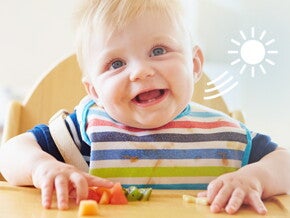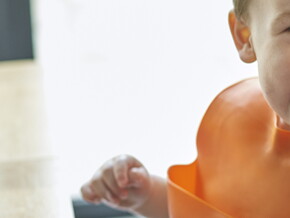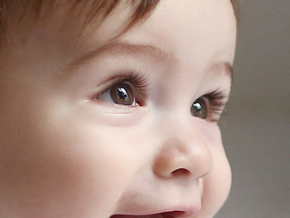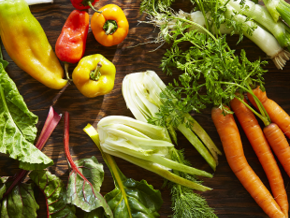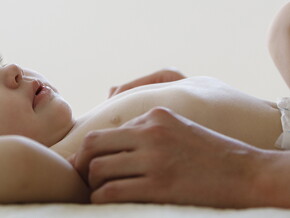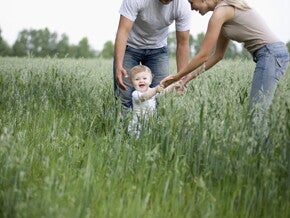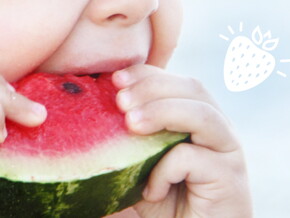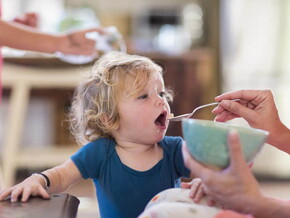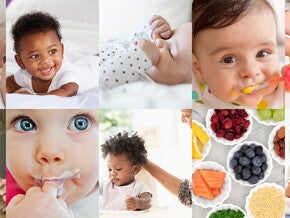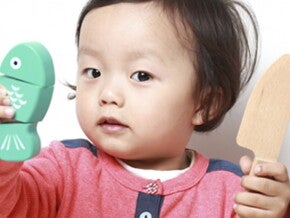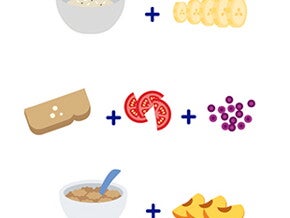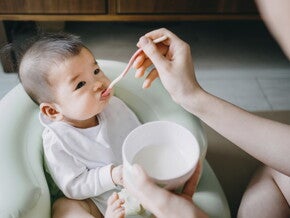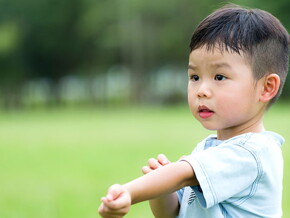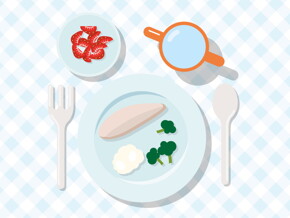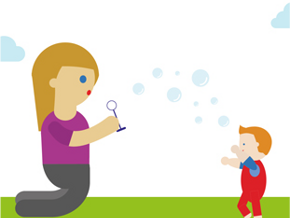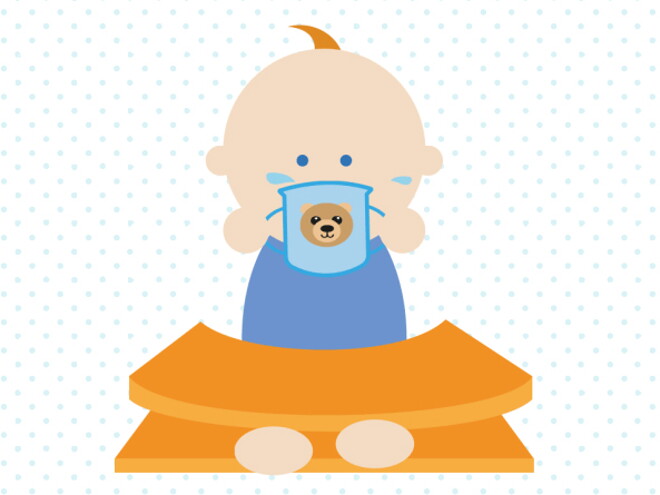
Introducing a cup is key to developing your toddler’s feeding skills
Your toddler’s developing feeding skills
3 reasons to drink from a cup
Did you know? Prolonged use of bottles is linked with a higher chance of tooth decay and becoming overweight. The American Academy of Pediatrics (AAP) recommends that toddlers be off bottles before 18 months of age.
If you haven’t already introduced your toddler to drinking from a cup, now is a good time to try.
- By 12 months of age, most babies have the coordination skills needed to hold a cup and drink from it.
- Your toddler is ready to drink from an open cup, rather than a lidded or sippy cup, or can even use a cup with a straw.
- Now that your baby has reached her first birthday, she can drink whole cow’s milk, or may be drinking growing-up milks, so it’s a good idea to introduce a cup at the same time.

Which milk when?
Which? With cow’s milk now an option for your toddler, you may be wondering which milk to choose. Whole (full-fat) cow’s milk is an appropriate choice for toddlers at this age. Specially designed growing-up milk can also be an option. Alternative types of non-dairy milk, such as soy, almond, rice, and coconut, might not contain enough protein and calcium to meet your growing toddler’s needs. They can also be a source of unnecessary added sugars in the form of flavorings. Check with your healthcare professional before introducing these non-dairy types of milk.
When? Most healthcare professionals recommend introducing cow’s milk at around 12 months of age. You may be advised to gradually introduce cow’s milk by mixing it with breast milk. Check with your healthcare professional if you have any concerns.
Why? Fat is an important and necessary nutrient in your toddler’s diet. Whole milk contains around one and a half teaspoons of fat per cup, compared with only one teaspoon per cup in low-fat (2%) milk. While you may choose low-fat milk for yourself, remember that your toddler needs the fat in whole milk for healthy growth.

Dos and don’ts when drinking from a cup
By now your toddler is enjoying her developing independence with finger-feeding. Learning to drink from a cup is one more skill for her on the path to becoming an independent eater.
Do use small, toddler-sized cups and fill them up. This will make it easier to master the skill of drinking as she doesn’t have to tip the cup up too much.
Don’t worry if she drops or throws her cup away once she’s finished—this is her way of telling you she has had enough to drink.
Do be patient and allow your child plenty of practice. She’ll get there eventually.
Don’t rush or pressure her to drink faster. It won’t help her develop the skill more quickly.
Do expect spillages—especially as she learns to drink from an open cup. Spilling is likely to happen at all three stages of drinking—bringing the cup to her mouth, drinking, and taking the cup away from her mouth.
Don’t get upset if she makes a mess. It’s all part of the learning experience.
Do choose plastic, easy-to-grip cups.
Don’t let her carry the cup everywhere she goes.
Do offer a cup of water with meals and throughout the day.
Don’t put her to bed with a cup.
Do use cups that hold 120-180ml (4-6oz), which is an appropriate amount for her age and size.
Don’t be concerned if your toddler doesn’t show all of these skills yet. Every child develops differently.

Be water wise
Up until your little one’s first birthday, breast milk and water were the only drinks recommended. This is because breast milk, along with a balanced diet, provided all the nutrition she needed. Now that she’s one year old, in addition to breast milk and water, she can also be offered whole cow’s milk and specially designed growing-up milk.
Water is…
…hydrating As well as being involved in practically all bodily functions, water helps make sure your toddler is staying properly hydrated.
…calorie-free Water doesn’t contain any calories, so all your toddler’s energy needs can come from nutritious foods, breast milk, and cow’s milk.
…teeth-safe Because it doesn’t contain any sugars, water won’t damage your toddler’s teeth.
Some parents and caregivers offer toddlers sugar-sweetened beverages or other soft drinks. These can have a negative effect on your toddler’s health and teeth.
Soft drinks can be…
…high in calories Sugar-sweetened beverages contain a large number of calories. Drinking a lot of these may mean that your toddler is consuming more calories than she needs on a daily basis. This can lead to unhealthy weight gain.
…full of sugar Fizzy drinks, juice drinks, and flavored waters can contain a surprising amount of added sugar. The World Health Organization recommends reducing “free sugar” (which includes sugar in unsweetened fruit juices and smoothies) intake in the daily diets of both adults and children.
…harmful to teeth Added sugars in drinks can cause tooth decay. The bacteria naturally found in your toddler’s saliva reacts with the sugars to produce acids which can damage teeth. To help promote healthy teeth and gums, remember to brush your little one’s teeth twice a day. Use a smear (the size of a grain of rice) of fluoride toothpaste specifically made for toddlers.
Role model healthy-drinking choices. If your little one sees you enjoying water, she’s more likely to drink water too. Juice is not necessary in your toddler’s diet. Offering whole fruit is a better option. If you do decide to offer juice, follow these tips:
• Choose 100% juice and avoid “fruit drinks” and “juice drinks”, which may contain added sugar (and not much real fruit).
• Don’t give your toddler more than 120ml (4oz) of juice in one day.
• Make the juice part of a meal or snack.

Your family-mealtime essentials kit
Preparation is key when it comes to pleasant mealtimes for the whole family. It’s as important to think about how you offer your toddler food as what you offer her. Provide a warm, nurturing environment, without any pressure on your toddler to eat. Having these items ready may help you feel more relaxed, giving you the chance to engage and interact with your toddler for a shared family meal.
• Highchair
Keep your toddler safe by strapping her into a highchair that is pulled up to the family table. Remember that she has a short attention span so may not be able to sit there for a long time. It’s a good idea to wait until her meal is ready (and cool enough to eat) before putting her in the highchair.
• Mat or floor covering
Your little one is still learning to feed herself so don’t be surprised if some food misses the target and ends up on the floor. She may also be more interested in playing with food than eating it. This is completely normal. If she starts throwing food or utensils, it may be a sign she’s finished. Remind her that throwing is not allowed. If it continues, take her out of her highchair and let her know that she can continue to play—just not with her food.
• Bib
Encourage your toddler to feed herself, even though she hasn’t completely mastered her cutlery skills quite yet. She may be able to get food onto a spoon, but it might not all make it into her mouth without spilling. Protect her clothes with a bib or covering and offer a combination of finger foods and foods that she can try to spoon-feed herself.
• Cloth or baby wipes
Toddlers discover new foods and textures with all their senses. Wanting to touch, smear, and squish foods instead of eating them is completely natural. Let her explore and get messy during the meal. Then be ready for the big clean-up once she’s finished.
• Training cup and/or straw
Offer milk or water in an appropriately sized cup with easy-to-hold handles. You can try a training cup with a spout (free-flow rather than with a valve) but aim for an open cup or even a cup with a straw. This will help your little one learn to sip rather than suck.
• Toddler-size cutlery
Little hands need little spoons, forks, and (non-sharp) knives. Cutlery with easy-grip handles can make it easier for her to control.
• Patience!
Your toddler is busy learning a lifetime skill and needs to practice in her own time. She’ll probably take longer to finish her meal than the rest of the family, so try not to rush her. Keep the atmosphere pleasant and take the opportunity to enjoy a conversation as a family. That way, she’s learning eating and social skills at the same time.
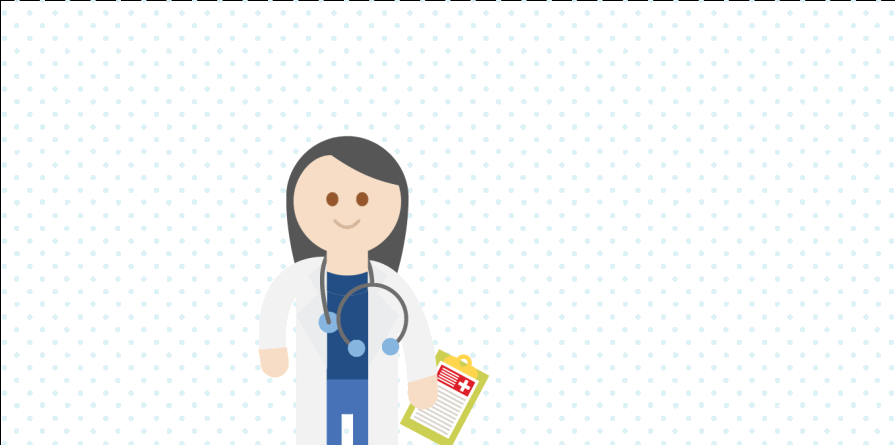
Don’t forget about how you are offering food to your toddler!
Even though your toddler is becoming more independent at the dinner table, your parent feeding style is still important for her future health. “Indulgent or uninvolved parenting has been associated with children’s higher body weight,” explains Lisa Fries, PhD, Behavioral Science Specialist at Nestlé Research in Switzerland. “A responsive feeding style is linked to healthier weight and dietary intake in children. For toddlers, this means offering a variety of foods in a warm, nurturing environment, and having structured mealtimes with consistent expectations (such as children eating at the table). As always, it is important to respond to your toddler’s hunger and fullness cues.” So, don’t forget to follow the principles of responsive feeding. See The dos and don’ts of responsive feeding and What’s your feeding style? for helpful reminders of good feeding practices for your little one.
Sources
Black MM, Aboud FE. Responsive feeding is embedded in a theoretical framework of responsive parenting. J Nutr 2011; 141(3): 490-4.
Bonuck K, Ben Avraham S, Hearst M, et al. Is overweight at 12 months associated with differences in eating behaviour or dietary intake among children selected for inappropriate bottle use? Matern Child Nutr 2014; 10(2):234-44.
Dattilo AM Programming long-term health: Effect of parent feeding approaches on long-term diet and eating patterns. In: Early nutrition and long-term health, mechanisms, consequences and opportunities. Ed., Saavedra and Dattilo, Elsevier, 2017: 471-95.
Gooze RA, Anderson SE, Whitaker RC. Prolonged bottle use and obesity at 5.5 years of age in US children. J Pediatr 2011; 159(3):431-6.
Hurley KM, Cross MB, Hughes SO. A systematic review of responsive feeding and child obesity in high-income countries. J Nutr 2011; 141(3):495–501.
Shloim N, Edelson LR, Martin N, et al. Parenting styles, feeding styles, feeding practices, and weight status in 4-12 year-old children: A systematic review of the literature. Front Psychol 2015; 6:1849. doi: 10.3389/fpsyg.2015.01849.
Sleddens EF, Gerard SM, Thijs C, et al. General parenting, childhood overweight and obesity-inducing behaviors: a review. Int J Pediatr Obes 2011; 6(2-2): e12–27.
Vollmer RL, Mobley AR. Parenting styles, feeding styles, and their influence on child obesogenic behaviors and body weight: a review. Appetite 2013; 71:232-41.
World Health Organization. Guideline: Sugars intake for adults and children. Geneva: World Health Organization; 2015.
https://www.aap.org/en-us/about-the-aap/aap-press-room/aap-press-room-m… (Accessed August 8 2018)
https://www.aap.org/en-us/about-the-aap/aap-press-room/Pages/American-A…
(Accessed August 8 2018)
